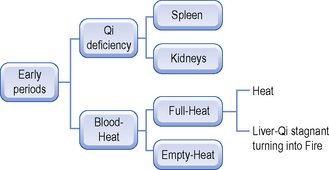CHAPTER 8 Early Periods
Aetiology
Pathology
Thus, the pathology of this condition falls into two broad groups, the first from Qi deficiency, the second from Blood-Heat. Within the first group is Spleen-Qi or Kidney-Qi deficiency; within the second group, Full-Heat or Empty-Heat (see Fig. 8.1). Deficient Qi (whether Spleen- or Kidney-Qi) fails to hold blood in the vessels. Blood-Heat (whether deriving from Full- or Empty-Heat) pushes the blood out of the vessels.
Identification of patterns and treatment
All the herbal prescriptions in the following chapters are detailed in Appendix 1 on p. 937.
Qi deficiency
Spleen-Qi deficiency
Treatment principle
Strengthen the Spleen, tonify and raise Qi, consolidate the Penetrating Vessel, contain blood.
Herbal treatment
a Prescription
b Prescription
c Prescription
Explanation
– Chen Pi resolves Dampness: it is added to counteract and balance the cloying nature of Qi and Blood tonics.
Modifications
These modifications apply to all three prescriptions.
• If there is Yang deficiency, add herbs that warm the Uterus, scatter Cold and stop bleeding such as Ai Ye Folium Artemisiae argyi, Pao Jiang Rhizoma Zingiberis preparatum (fried) or Bu Gu Zhi Fructus Psoraleae.
• If there is stasis of Blood, add Qian Cao Gen Radix Rubiae, Yi Mu Cao Herba Leonori and San Qi Radix Notoginseng.




